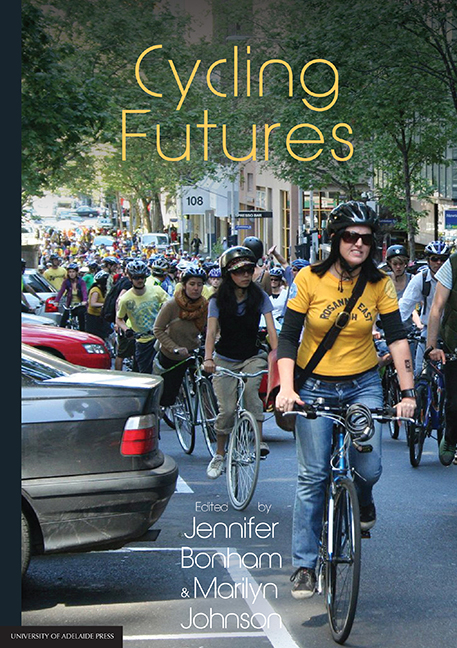Book contents
- Frontmatter
- Contents
- Preface
- Editors
- Contributors
- PART I Current challenges
- 1 Cycling: Bringing the future into the present
- 2 A glimpse at Australia's cycling history
- 3 Health benefits of cycling
- 4 An epidemiological profile of cycling injury in Australia and New Zealand
- 5 Faster than the speed of bikes
- 6 Economics of everyday cycling and cycling facilities
- 7 Cycling and sustainable transport
- 8 Cycle touring
- PART II Strategies for change
1 - Cycling: Bringing the future into the present
from PART I - Current challenges
Published online by Cambridge University Press: 25 July 2017
- Frontmatter
- Contents
- Preface
- Editors
- Contributors
- PART I Current challenges
- 1 Cycling: Bringing the future into the present
- 2 A glimpse at Australia's cycling history
- 3 Health benefits of cycling
- 4 An epidemiological profile of cycling injury in Australia and New Zealand
- 5 Faster than the speed of bikes
- 6 Economics of everyday cycling and cycling facilities
- 7 Cycling and sustainable transport
- 8 Cycle touring
- PART II Strategies for change
Summary
Introduction
Inspired by the growing interest in cycling across Australasia, Cycling futures brings together work by both well-established and emerging cycling scholars from Australia and New Zealand. Australasian cycling research has been developing alongside the steady growth in cycling. Since the early 2000s, reported rates of cycling participation have been increasing (Department of Communications, Information Technology and the Arts, 2011). In 2015, more than 4 million Australians (17.4%) had ridden their bicycle in the previous week, while over a third (36.3%) had ridden in the previous year (Australian Bicycle Council & Austroads, 2015). In New Zealand, in 2009-13, a third of the population (34%) cycled in the previous year, with 19% of New Zealanders reporting cycling in the last month (Ministry of Transport, 2013). This increase across Australasia reflects the growing interest in cycling in towns and cities across the globe.
Cycling participation rates in the Netherlands and Denmark are well documented, and attempts to foster alternative-mobility futures are gaining momentum around the world. The implementation of cycling-friendly policies and cycling infrastructure in global (and aspiring global) cities sends a powerful message about the changing future of urban mobility. New York City has been installing cycling facilities for almost two decades (Chen et al., 2012), while some areas of London report that cycling now comprises 16% of vehicle journeys (Transport for London, 2013, p. 5). Tokyo has continued its long tradition of cycling with an estimated 14% of journeys being made by bike (Kidd, 2013); and in Paris, the pervasive Velib bike-share scheme provides a well-patronised, practical option for the city's residents and tourists (Beroud & Anaya, 2012).
Cycling has remained a significant means of travel in China despite policies through the 1990s and early 2000s which either sought to reduce bicycle use (Zacharias, 2002; Haixiao, 2012) or eroded conditions for cyclists (Wang, 2011a; 2011b). Bicycles constitute more than 15% of journeys in cities such as Beijing and more than 50% of journeys in cities like Tianjin (Wang, 2011b; Haixiao, 2012). Perhaps more importantly, changes in central government thinking since 2005 have fostered a reassessment of the role of the bicycle in urban China, facilitating the incorporation of cycling into city planning and the spectacular development of bike-share schemes (Haixiao, 2012, pp. 163 & 169).
- Type
- Chapter
- Information
- Cycling Futures , pp. 3 - 24Publisher: The University of Adelaide PressPrint publication year: 2015

